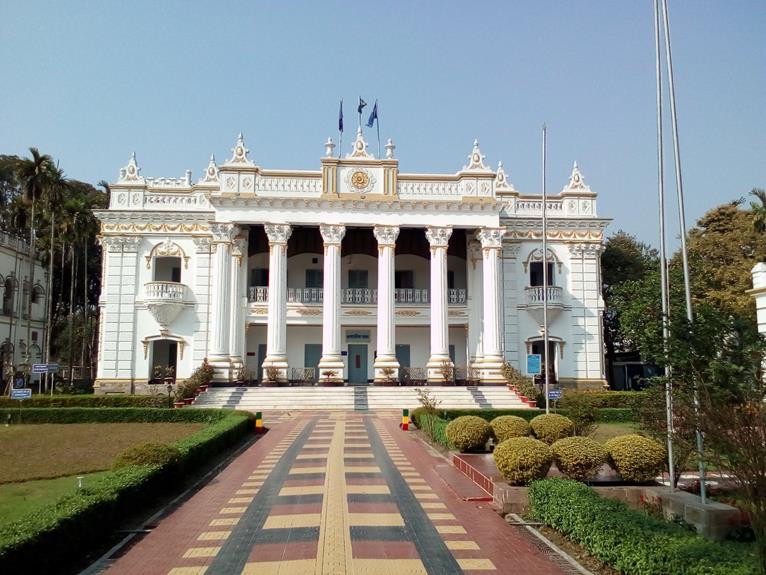Manikganj District: A History of Liberation and Tragedy unveils the captivating tale of a region that has witnessed both triumph and sorrow throughout its existence. From its establishment as a subdivision of Dhaka District in 1845 to its emergence as a full-fledged district in 1984, Manikganj has played a pivotal role in the War of Liberation. The heroic exploits of figures like Abdul Halim Chowdhury and Abdul Matin Chowdhury have been etched into the annals of history, showcasing the unwavering spirit of the district's inhabitants. However, amidst moments of liberation, tragedy has also cast a grim shadow over Manikganj. The devastating Daulatpur-Saturia tornado of 1989 stands as a stark reminder of the district's resilience in the face of adversity. As we delve into the history of Manikganj District, we will uncover the intricacies of its geography, the diversity of its demographics, and the remarkable personalities it has produced. Brace yourself for a journey that will both enlighten and captivate, as we explore the tales of liberation and tragedy that have shaped Manikganj District.
Establishment and Administrative Changes
How has the establishment and administrative structure of Manikganj District evolved over time? The timeline of Manikganj District's establishment dates back to 1845 when it was established as a subdivision of Dhaka District. Initially, it was a subdivision of Faridpur District. In 1956, it became a part of Dhaka District for administrative purposes. However, in 1984, Manikganj was declared a full district. These administrative changes have had a significant impact on the development and governance of the district. The transition from a subdivision to a full district has provided Manikganj with more autonomy and resources to address the needs of its population. It has allowed for more focused and localized decision-making, ensuring better governance and development outcomes for the district.
Liberation War and Heroes
During the liberation war of 1971, Manikganj District witnessed the heroic efforts and sacrifices of Abdul Halim Chowdhury, Abdul Matin Chowdhury, Principal Abdur Rouf Khan, and other brave individuals who led and organized the fight for freedom. These heroes played a crucial role in mobilizing the people of Manikganj, inspiring them to join the liberation movement against Pakistani occupation. The district also saw the active participation of women in the liberation war, who served as fighters, nurses, and supporters of the cause. Their bravery and resilience were instrumental in the success of the liberation movement. However, the district also faced the tragedy of the Daulatpur-Saturia tornado in 1989. This devastating natural disaster took the lives of thousands of people, destroyed towns, and left many homeless. Despite this tragedy, the spirit of liberation and resilience continued to thrive in Manikganj District.
| Role of women in the liberation war | Impact of the Daulatpur-Saturia tornado on the district |
|---|---|
| Women served as fighters, nurses, and supporters in the liberation war | The tornado in 1989 caused massive destruction, loss of lives, and displacement of people |
| Their bravery and resilience played a crucial role in the liberation movement | Towns were leveled, and thousands were left homeless |
| Women's participation was instrumental in the success of the liberation movement | The district faced a significant tragedy and had to rebuild after the tornado |
| Their contributions deserve recognition and gratitude | The impact of the tornado on the district was devastating |
The Nuruni Ganga Battle
Amidst the heroic efforts and sacrifices of Abdul Halim Chowdhury, Abdul Matin Chowdhury, Principal Abdur Rouf Khan, and other brave individuals during the liberation war of 1971 in Manikganj District, one significant battle that stands out is the Nuruni Ganga Battle. This battle had a profound impact on the overall liberation war. The Nuruni Ganga Battle took place on 29 October 1971 and resulted in the death of 81 Pakistani soldiers. The local heroes played a crucial role in this battle, displaying immense courage and determination. Their strategic planning and relentless fighting contributed to the defeat of the Pakistani forces. The Nuruni Ganga Battle served as a turning point in the liberation war, boosting the morale of the freedom fighters and inspiring them to continue their fight for independence. The bravery and resilience exhibited by the local heroes in this battle remain etched in the history of Manikganj District.
Singair Upazila's Liberation
Singair Upazila's liberation was a significant milestone in the liberation war of 1971 in Manikganj District. The role of Singair Upazila in the liberation war was crucial, as it witnessed fierce battles between the Pakistani forces and the freedom fighters. On 13 November 1971, Singair Upazila was finally freed from Pakistani occupation. This victory played a vital role in boosting the morale of the freedom fighters and strengthening their resolve to achieve independence. However, Singair Upazila also faced a devastating tragedy in its history. On 26 April 1989, the Daulatpur-Saturia tornado struck Manikganj, including Singair Upazila. This tornado was the deadliest in recorded history, causing extensive destruction and claiming the lives of many people. The impact of this natural disaster further added to the challenges faced by Singair Upazila and the entire district of Manikganj.
| Date | Event |
|---|---|
| 29 October 1971 | Significant liberation fight on the Nuruni Ganga resulting in the death of 81 Pakistani soldiers |
| 13 November 1971 | Singair Upazila freed from Pakistani occupation |
| 26 April 1989 | Daulatpur-Saturia tornado strikes Manikganj, causing extensive destruction and loss of lives |
Freedom Fighters' Victories
After the liberation of Singair Upazila from Pakistani occupation on 13 November 1971, the freedom fighters of Manikganj District achieved several significant victories in their relentless pursuit of independence. These victories were the result of the freedom fighters' strategic planning and execution, as well as their unwavering determination to free their land from oppression. The impact of the liberation war in Manikganj District was profound, as it not only brought freedom and independence to the people but also instilled a sense of pride and unity among them. The victories of the freedom fighters served as a catalyst for the liberation of the entire district, inspiring others to join the cause and fight for their rights. The strategies employed by the freedom fighters, such as guerrilla warfare and ambush tactics, played a crucial role in weakening the Pakistani forces and ultimately leading to their defeat. The liberation war in Manikganj District was a turning point in the history of Bangladesh, marking the beginning of a new era of freedom and self-determination.
Declaration of Sub-division's Freedom
The sub-division of Manikganj in Bangladesh was officially declared free during the liberation war in 1971, marking a significant milestone in the struggle for independence. This declaration came after numerous battles and sacrifices made by the brave freedom fighters in the district. The people of Manikganj rejoiced as they finally gained their freedom from Pakistani occupation.
The declaration of the sub-division's freedom had a profound impact on the residents of Manikganj. It instilled a sense of pride and patriotism among the population, inspiring them to continue fighting for the liberation of the entire country. However, the joy of freedom was marred by the tragic event of the Daulatpur-Saturia tornado in 1989. This devastating tornado resulted in the loss of thousands of lives and the destruction of homes and infrastructure, leaving the people of Manikganj devastated. Despite this tragedy, the spirit of resilience and determination among the residents remained strong, as they worked together to rebuild their lives and their beloved district.
| Declaration of Sub-division's Freedom | Impact of the Daulatpur Saturia tornado |
|---|---|
| Officially declared free in 1971 | Occurred in 1989 |
| Significant milestone in the struggle for independence | Resulted in loss of thousands of lives |
| Filled people with pride and patriotism | Devastated the district |
| Inspired continued fight for liberation | Destroyed homes and infrastructure |
| Required collective effort for rebuilding |
The Daulatpur-Saturia Tornado
The Daulatpur-Saturia tornado, which occurred in Manikganj in 1989, stands as one of the deadliest tornadoes in recorded history, leaving a trail of destruction and devastating the district. The impact and aftermath of the tornado were catastrophic, with 1,300 people initially reported as killed and 12,000 injured. The towns of Saturia and Manikganj Sadar were leveled, rendering approximately 80,000 people homeless. The tornado had a profound effect on the district, necessitating extensive rebuilding and recovery efforts. Despite the immense challenges, the community rallied together to rebuild their lives and restore the infrastructure. Rehabilitation programs were implemented to provide shelter, healthcare, and support to the affected population. Additionally, initiatives were undertaken to restore damaged buildings, roads, and utilities. Through resilience and determination, the district slowly recovered from the tragedy, demonstrating the strength of the human spirit in the face of adversity.
Geographic Features
Manikganj District is characterized by diverse geographic features that contribute to its rich natural beauty and agricultural productivity. Situated in the central part of Bangladesh, the district is blessed with several rivers, including the Padma, Kaliganga, Jamuna, Dhaleshwari, and Ichamati. These rivers not only provide a picturesque landscape but also serve as an important source of water for irrigation and transportation. However, the district is also prone to natural disasters, such as floods and cyclones, due to its geographical location. Despite these challenges, Manikganj has experienced significant population growth over the years, with a population of 1,558,024 as per the 2022 Census. This growth has necessitated the development of infrastructure and services to support the increasing needs of the residents. The district's geographic features, combined with its population growth, make it a unique and dynamic place in Bangladesh.
Demographic Overview
Situated in the central part of Bangladesh, Manikganj District showcases a diverse demographic landscape that reflects the cultural and religious diversity of its population. With a population of 1,558,024 according to the 2022 Census, the district has a population density of 1,126 people per square kilometer. Approximately 14.8% of the population resides in urban areas. The literacy rate for those aged 7 and over is 71.1%. Islam is the dominant religion in Manikganj District, with a significant Muslim population. The district is home to various places of worship, including mosques, temples, churches, Buddhist temples, and a pagoda, highlighting the religious diversity of the area. These population statistics and religious diversity contribute to the vibrant social fabric of Manikganj District.
Notable Personalities
Several individuals from diverse fields have emerged as notable personalities from Manikganj District, leaving an indelible mark on their respective domains and contributing to the district's cultural and intellectual heritage. These famous individuals have excelled in various fields such as acting, politics, journalism, literature, and sports. To showcase the cultural diversity and achievements of these personalities, a table highlighting some of them is provided below:
| Field | Famous Individuals |
|---|---|
| Acting | Aruna Biswas |
| Politics | Abdul Halim Chowdhury |
| Journalism | Bulbul Chowdhury |
| Literature | Munier Chowdhury |
| Activism | Hemantakumari Devi |
These individuals have not only brought recognition to themselves but have also contributed to the cultural richness and intellectual development of Manikganj District. Their accomplishments serve as an inspiration for future generations and highlight the district's vibrant and diverse talent pool.
Frequently Asked Questions
What Is the Current Population of Manikganj District?
The current population of Manikganj District is 1,558,024, according to the 2022 Census. The district has a population density of 1,126 people per square kilometer, with 14.8% residing in urban areas. The demographic trends show a significant Muslim population, with Islam being the dominant religion. The literacy rate, for those aged 7 and over, stands at 71.1%. Manikganj District is home to various places of worship, including mosques, temples, churches, Buddhist temples, and a pagoda.
How Many People Were Initially Reported as Killed in the Daulatpur-Saturia Tornado?
Initially, 1,300 people were reported as killed in the Daulatpur-Saturia tornado, which struck Manikganj District on 26 April 1989. This devastating tornado had a significant impact on the local infrastructure, resulting in the leveling of the towns of Saturia and Manikganj Sadar. Additionally, approximately 80,000 people were left homeless, and 12,000 individuals were injured. The tornado stands as the deadliest tornado in recorded history, leaving a lasting impact on the district and its inhabitants.
What Is the Annual Average Rainfall in Manikganj District?
The average annual rainfall in Manikganj District is 2,376mm (93.5in). The district experiences diverse climate patterns, with maximum temperatures reaching 36°C and minimum temperatures dropping to 12.7°C. Located in Bangladesh, Manikganj District is known for its numerous rivers, including the Padma River, Kaliganga River, Jamuna River, Dhaleshwari River, and Ichamati River. These water bodies contribute to the district's rich agricultural resources and play a vital role in the lives of its residents. The annual average precipitation in Manikganj District sustains the local ecosystem and supports various economic activities.
Which Rivers Flow Through Manikganj District?
Manikganj District is blessed with the presence of several rivers that flow through its territory. These rivers play a vital role in the district's flood situation and impact, as well as in supporting agricultural activities and the irrigation system. The Padma River, Kaliganga River, Jamuna River, Dhaleshwari River, and Ichamati River are the prominent rivers that traverse the district. These water bodies not only contribute to the natural beauty of the region but also serve as essential resources for the livelihoods of the local population.
Who Is the Current Minister for Health and Family Welfare in Manikganj District?
The current Minister for Health and Family Welfare in Manikganj District is Zahid Maleque. As the minister, he is responsible for overseeing and implementing various healthcare initiatives in the district. The healthcare system in Manikganj faces several challenges, including inadequate infrastructure, limited access to quality healthcare services, and a shortage of skilled medical professionals. Efforts are being made to address these challenges and improve healthcare delivery in the district through the implementation of various programs and policies.





